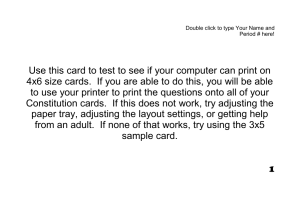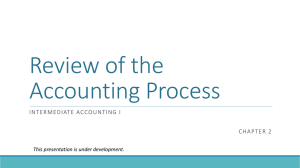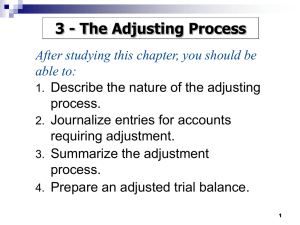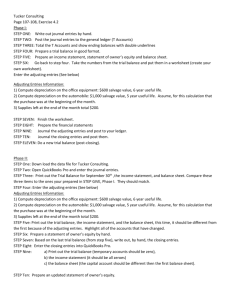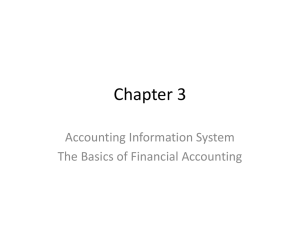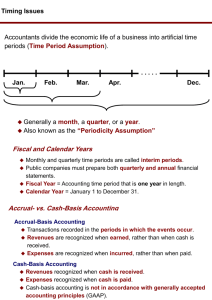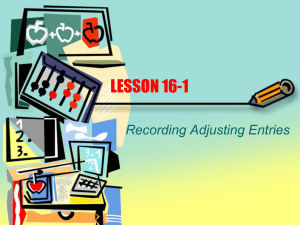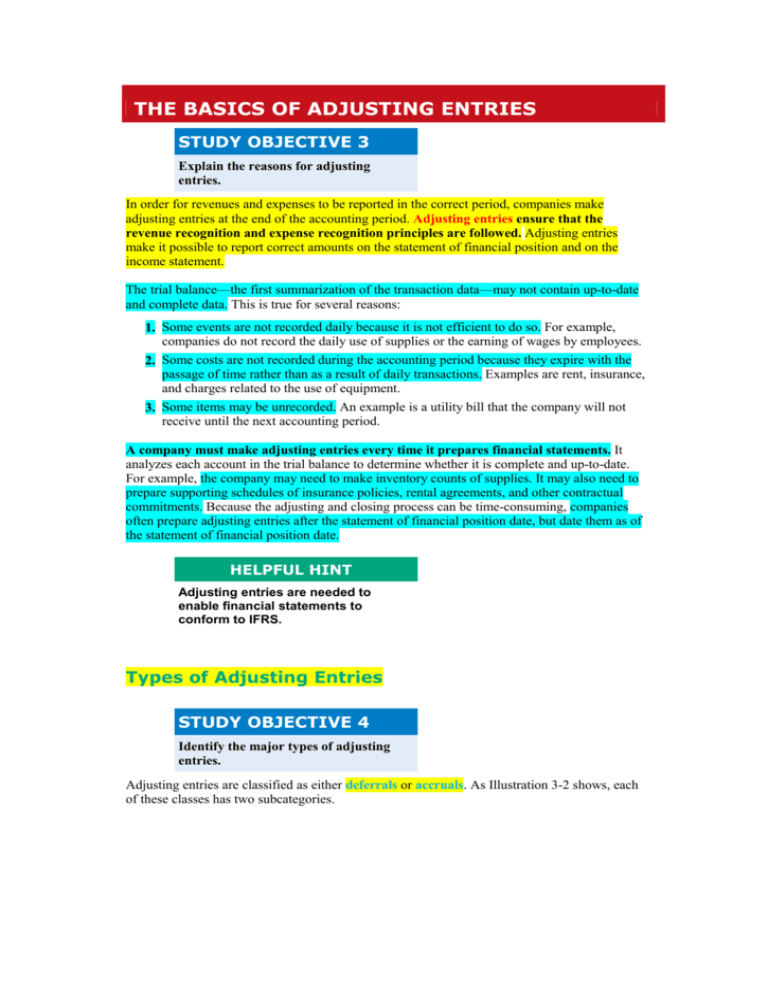
THE BASICS OF ADJUSTING ENTRIES
STUDY OBJECTIVE 3
Explain the reasons for adjusting
entries.
In order for revenues and expenses to be reported in the correct period, companies make
adjusting entries at the end of the accounting period. Adjusting entries ensure that the
revenue recognition and expense recognition principles are followed. Adjusting entries
make it possible to report correct amounts on the statement of financial position and on the
income statement.
The trial balance—the first summarization of the transaction data—may not contain up-to-date
and complete data. This is true for several reasons:
1. Some events are not recorded daily because it is not efficient to do so. For example,
companies do not record the daily use of supplies or the earning of wages by employees.
2. Some costs are not recorded during the accounting period because they expire with the
passage of time rather than as a result of daily transactions. Examples are rent, insurance,
and charges related to the use of equipment.
3. Some items may be unrecorded. An example is a utility bill that the company will not
receive until the next accounting period.
A company must make adjusting entries every time it prepares financial statements. It
analyzes each account in the trial balance to determine whether it is complete and up-to-date.
For example, the company may need to make inventory counts of supplies. It may also need to
prepare supporting schedules of insurance policies, rental agreements, and other contractual
commitments. Because the adjusting and closing process can be time-consuming, companies
often prepare adjusting entries after the statement of financial position date, but date them as of
the statement of financial position date.
HELPFUL HINT
Adjusting entries are needed to
enable financial statements to
conform to IFRS.
Types of Adjusting Entries
STUDY OBJECTIVE 4
Identify the major types of adjusting
entries.
Adjusting entries are classified as either deferrals or accruals. As Illustration 3-2 shows, each
of these classes has two subcategories.
Illustration 3-2 Categories of adjusting entries
The following pages explain each type of adjustment and show examples. Each example is
based on the October 31 trial balance of Pioneer Advertising Agency Inc., from Chapter 2 and
reproduced in Illustration 3-3.
Illustration 3-3 Trial balance
We assume that Pioneer Advertising uses an accounting period of one month, and thus it
makes monthly adjusting entries. The entries are dated October 31.
Adjusting Entries for Deferrals
STUDY OBJECTIVE 5
Prepare adjusting entries for deferrals.
Deferrals are either prepaid expenses or unearned revenues. Companies make adjustments for
deferrals to record the portion of the deferral that represents the expense incurred or the
revenue earned in the current period.
PREPAID EXPENSES
Just as you might pay for your car insurance six months in advance, companies will pay in
advance for some items that cover more than one period. Because accrual accounting requires
that expenses are recognized only in the period in which they are incurred, these prepayments
are recorded as assets called prepaid expenses or prepayments. When expenses are prepaid,
an asset account is increased (debited) to show the service or benefit that the company will
receive in the future. Examples of common prepayments are insurance, supplies, advertising,
and rent. In addition, companies make prepayments when they purchase buildings and
equipment.
Prepaid expenses are costs that expire either with the passage of time (e.g., rent and
insurance) or through use (e.g., supplies). The expiration of these costs does not require daily
journal entries. Companies postpone recognizing these costs until they prepare financial
statements. At each statement date, they make adjusting entries: (1) to record the expenses that
apply to the current accounting period, and (2) to show the unexpired costs in the asset
accounts.
Prior to adjustment for prepaid expenses, assets are overstated and expenses are understated.
As shown in Illustration 3-4, an adjusting entry for prepaid expense increases (debits) an
expense account and decreases (credits) an asset account.
Illustration 3-4 Adjusting entries for prepaid expenses
Below, we will look in more detail at some specific types of prepaid expenses, beginning with
supplies.
Supplies. Businesses use various types of supplies such as paper, envelopes, and printer
cartridges. Companies generally debit supplies to an asset account when they acquire them. In
the course of operations, supplies are used, but companies postpone recognizing their use until
the adjustment process. At the end of the accounting period, a company counts the remaining
supplies. The difference between the balance in the Supplies (asset) account and the supplies
on hand represents the supplies used (an expense) for the period.
Equation analyses summarize the
effects of the transaction on the
elements of the accounting equation.
Pioneer Advertising Agency Inc. purchased advertising supplies costing $2,500 on October 5.
Pioneer recorded that transaction by increasing (debiting) the asset Advertising Supplies. This
account shows a balance of $2,500 in the October 31 trial balance. An inventory count at the
close of business on October 31 reveals that $1,000 of supplies are still on hand. Thus, the cost
of supplies used is $1,500 ($2,500 - $1,000). Pioneer makes the following adjusting entry.
Oct. 31
Advertising Supplies Expense
Advertising Supplies
1,500
1,500
(To record supplies used)
After the adjusting entry is posted, the two supplies accounts show:
Illustration 3-5 Supplies accounts after adjustment
The asset account Advertising Supplies now shows a balance of $1,000, which is equal to the
cost of supplies on hand at the statement date. In addition, Advertising Supplies Expense
shows a balance of $1,500, which equals the cost of supplies used in October. If Pioneer does
not make the adjusting entry, October expenses will be understated and net income
overstated by $1,500. Also, both assets and equity will be overstated by $1,500 on the
October 31 statement of financial position.
Insurance. Companies purchase insurance to protect themselves from losses due to fire,
theft, and other unforeseen events. Insurance must be paid in advance. Insurance premiums
(payments) normally are recorded as an increase (a debit) to the asset account Prepaid
Insurance. At the financial statement date companies increase (debit) Insurance Expense and
decrease (credit) Prepaid Insurance for the cost that has expired during the period.
On October 4, Pioneer Advertising Agency Inc. paid $600 for a one-year fire insurance policy.
Coverage began on October 1. Pioneer recorded the payment by increasing (debiting) Prepaid
Insurance. This account shows a balance of $600 in the October 31 trial balance. Insurance of
$50 ($600 ÷ 12) expires each month. Thus, Pioneer makes the following adjusting entry.
Oct. 31
Insurance Expense
Prepaid Insurance
50
50
(To record insurance expired)
After Pioneer posts the adjusting entry, the accounts show:
Illustration 3-6
Insurance accounts after adjustment
The asset Prepaid Insurance shows a balance of $550. This amount represents the unexpired
cost for the remaining 11 months of coverage. The $50 balance in Insurance Expense equals
the insurance cost that has expired in October. If Pioneer does not make this adjustment,
October expenses will be understated and net income overstated by $50. Also, both assets and
equity will be overstated by $50 on the October 31 statement of financial position.
Depreciation. Companies typically own buildings, equipment, and vehicles. These longlived assets provide service for a number of years. Thus, each is recorded as an asset, rather
than an expense, in the year it is acquired. As explained in Chapter 1, companies record such
assets at cost, as required by the cost principle. The term of service is referred to as the useful
life.
According to the expense recognition principle, companies then report a portion of the cost of
a long-lived asset as an expense during each period of the asset's useful life. Depreciation is
the process of allocating the cost of an asset to expense over its useful life in a rational and
systematic manner.
Need for Depreciation Adjustment. From an accounting standpoint, acquiring long-lived
assets is essentially a long-term prepayment for services. Companies need to make periodic
adjusting entries for depreciation, just as they do for other prepaid expenses. These entries
recognize the cost that has been used (an expense) during the period and report the unexpired
cost (an asset) at the end of the period.
When a company acquires a long-lived asset, it does not know its exact useful life. The asset
may be useful for a longer or shorter time than expected, depending on various factors. Thus,
depreciation is an estimate rather than a factual measurement of expired cost. A common
procedure in computing depreciation expense is to divide the cost of the asset by its useful life.
For example, if cost is $10,000 and useful life is expected to be 10 years, annual depreciation
is $1,000.1
Pioneer Advertising estimates depreciation on the office equipment to be $480 a year, or $40
per month. Thus, Pioneer makes the following adjusting entry to record depreciation for
October.
Oct. 31 Depreciation Expense
40
Accumulated Depreciation—Office Equipment
40
(To record monthly depreciation)
After the adjusting entry is posted, the accounts show:
Illustration 3-7 Accounts after adjustment for depreciation
The balance in the accumulated depreciation account will increase $40 each month. After
journalizing and posting the adjusting entry at November 30, the balance will be $80; at
December 31, $120; and so on.
Statement Presentation.
HELPFUL HINT
All contra accounts have increases,
decreases, and normal balances
opposite to the account to which they
relate.
Accumulated Depreciation—Office Equipment is a contra-asset account. That means that it
is offset against an asset account on the statement of financial position. This accumulated
depreciation account appears just after the account it offsets (in this case, Office Equipment)
on the statement of financial position. Its normal balance is a credit.
An alternative to using a contra-asset account would be to decrease (credit) the asset account
(e.g., Office Equipment) directly for the depreciation each month. But use of the contra
account is preferable for a simple reason: It discloses both the original cost of the equipment
and the total cost that has expired to date.
In the statement of financial position, Pioneer deducts Accumulated Depreciation—Office
Equipment from the related asset account, as follows.
Illustration 3-8 Statement of financial position presentation of accumulated depreciation
ALTERNATIVE
TERMINOLOGY
Book value is sometimes referred to
as carrying value or unexpired cost.
The difference between the cost of any depreciable asset and its related accumulated
depreciation is its book value. In Illustration 3-8, the book value of the equipment at the
statement of financial position date is $4,960. The book value of an asset generally differs
from its fair value—the price at which the asset could be sold in the marketplace. Remember
that depreciation is a means of cost allocation, not a matter of market valuation.
Depreciation expense identifies that portion of the asset's cost that has expired during the
period (in this case, in October). As for other prepaid adjustments, the omission of this
adjusting entry would cause assets, equity, and net income to be overstated and depreciation
expense to be understated.
If the company owns additional long-lived assets, such as store equipment or buildings, it
records depreciation expense on each of those items. It also establishes related accumulated
depreciation accounts, such as: Accumulated Depreciation—Store Equipment; and
Accumulated Depreciation—Buildings.
Illustration 3-9 summarizes the accounting for prepaid expenses.
Illustration 3-9 Accounting for prepaid expenses
UNEARNED REVENUES
When companies receive cash before service are performed they record a liability called
unearned revenue. In other words, a company now has a performance obligation (liability)
to transfer a service to one of its customers. Examples are rent, magazine subscriptions, and
customer deposits for future service. Airlines such as Ryanair (IRL), Qatar Airways (QAT),
and Southwest Airlines (USA), for instance, treat receipts from the sale of tickets as unearned
revenue until they provide the flight service. Similarly, colleges consider tuition received
prior to the start of a semester as unearned revenue.
Unearned revenues are the opposite of prepaid expenses. Indeed, unearned revenue on the
books of one company is likely to be a prepayment on the books of the company that made the
advance payment. For example, a landlord will have unearned rent revenue when a tenant has
prepaid rent.
When a company receives payment for services to be performed in a future accounting period,
it increases (credits) an unearned revenue account (a liability) to recognize the liability. Later,
the company earns revenues by providing service. It may not be practical to make daily journal
entries as the revenue is earned. Instead, we delay recognizing earned revenue until the end of
the period. Then the company makes an adjusting entry to record the revenue that has been
earned and to show the liability that remains. Typically, prior to adjustment, liabilities are
overstated and revenues are understated. Therefore, as shown in Illustration 3-10, the
adjusting entry for unearned revenues results in a decrease (a debit) to a liability account
and an increase (a credit) to a revenue account.
Illustration 3-10
Adjusting entries for unearned revenues
ALTERNATIVE
TERMINOLOGY
Unearned revenue is sometimes
referred to as deferred revenue.
Pioneer Advertising Agency Inc. received $1,200 on October 2 from R. Knox for advertising
services expected to be completed by December 31. Pioneer credited the payment to Unearned
Service Revenue; this account shows a balance of $1,200 in the October 31 trial balance.
Analysis reveals that the company earned $400 of those fees in October. Thus, it makes the
following adjusting entry.
Oct. 31
Unearned Revenue
Service Revenue
400
400
(To record revenue for services provided)
After the company posts the adjusting entry, the accounts show:
Illustration 3-11
Revenue accounts after prepayments adjustment
The liability Unearned Revenue now shows a balance of $800. That amount represents the
remaining prepaid advertising services to be performed in the future. At the same time, Service
Revenue shows total revenue of $10,400 earned in October. Without this adjustment, revenues
and net income are understated by $400 in the income statement. Also, liabilities are
overstated and equity understated by $400 on the October 31 statement of financial position.
Illustration 3-12 summarizes the accounting for unearned revenues.
Illustration 3-12
Accounting for unearned revenues
ACCOUNTING ACROSS THE ORGANIZATION
Turning Gift Cards into Revenue
Tom Hahn/iStockphoto
Those of you interested in marketing know that gift cards are among the hottest
tools in merchandising today. Customers purchase gift cards and give them to
someone for later use. In a recent year, gift-card sales topped $95 billion.
Although these programs are popular with marketing executives, they create
accounting questions. Should revenue be recorded at the time the gift card is
sold, or when it is used by the customer? How should expired gift cards be
accounted for? In its 2008 statement of financial position, Best Buy (USA)
reported unearned revenue related to gift cards of $531 million.
Suppose that Robert Jones purchases a €100 gift voucher at Carrefour (FRA)
on December 24, 2011, and gives it to his wife, Devon, on December 25,
2011. On January 3, 2012, Devon uses the voucher to purchase €100 worth of
CDs. When do you think Carrefour should recognize revenue, and why?
Answer:
According to the revenue recognition principle, companies should recognize
revenue when earned. In this case, revenue is not earned until Carrefour
provides the goods. Thus, when Carrefour receives cash in exchange for the
gift voucher on December 24, 2011, it should recognize a liability, Unearned
Revenue, for €100. On January 3, 2012, when Devon Jones exchanges the
voucher for merchandise, Carrefour should recognize revenue and eliminate
€100 from the balance in the Unearned Revenue account.
Source: Robert Berner, “Gift Cards: No Gift to Investors,” Business Week (March
14, 2005), p. 86.
before you go on...
Adjusting Entries—Deferrals
The ledger of Zhu Company, a Chinese business, on March 31, 2011, includes the
following selected accounts before adjusting entries.
Debit
Credit
Prepaid Insurance
3,600,000
Office Supplies
2,800,000
Office Equipment
25,000,000
Accumulated Depreciation—Office Equipment
5,000,000
Unearned Revenue
9,200,000
An analysis of the accounts shows the following.
1. Insurance expires at the rate of ¥100,000 per month.
2. Supplies on hand total ¥800,000.
3. The office equipment depreciates ¥200,000 a month.
4. One-half of the unearned revenue was earned in March.
Prepare the adjusting entries for the month of March.
Action Plan
Make adjusting entries at the end of the period for revenues earned and
expenses incurred in the period.
Don't forget to make adjusting entries for prepayments. Failure to adjust for
prepayments leads to overstatement of the asset or liability and related
understatement of the expense or revenue.
Solution
1.
Insurance Expense
Prepaid Insurance
100,000
100,000
(To record insurance expired)
2.
Office Supplies Expense
2,000,000
Office Supplies
2,000,000
(To record supplies used)
3.
Depreciation Expense
200,000
Accumulated Depreciation—Office
Equipment
200,000
(To record monthly depreciation)
4.
Unearned Revenue
4,600,000
Service Revenue
4,600,000
(To record revenue for services
provided)
Related exercise material: BE3-3, BE3-4, BE3-5, BE3-6, and
3-2.
Adjusting Entries for Accruals
STUDY OBJECTIVE 6
Prepare adjusting entries for accruals.
The second category of adjusting entries is accruals. Companies make adjusting entries for
accruals to record revenues earned and expenses incurred in the current accounting period that
have not been recognized through daily entries.
ACCRUED REVENUES
Revenues for service performed but not yet recorded at the statement date are accrued
revenues. Accrued revenues may accumulate (accrue) with the passing of time, as in the case
of interest revenue and rent revenue. Or they may result from services that have been
performed but are neither billed nor collected. The former are unrecorded because the earning
process (e.g., of interest and rent) does not involve daily transactions. The latter may be
unrecorded because the company has provided only a portion of the total service.
An adjusting entry for accrued revenues serves two purposes: (1) It shows the receivable that
exists at the statement of financial position date, and (2) it records the revenues earned during
the period. Prior to adjustment, both assets and revenues are understated. Therefore, as
Illustration 3-13 shows, an adjusting entry for accrued revenues increases (debits) an asset
account and increases (credits) a revenue account.
Illustration 3-13
Adjusting entries for accrued revenues
In October Pioneer Advertising Agency Inc. earned $200 for advertising services that have not
been recorded. Pioneer makes the following adjusting entry on October 31.
Oct. 31
Accounts Receivable
Service Revenue
(To record revenue for services provided)
200
200
After Pioneer posts the adjusting entry, the accounts show:
Illustration 3-14 Receivable and revenue accounts after accrual adjustment
ETHICS NOTE
Computer Associates International
(USA) was accused of backdating
sales—that is, saying that a sale that
occurred at the beginning of one
quarter occurred at the end of the
previous quarter, in order to achieve
the previous quarter's sales targets.
The asset Accounts Receivable indicates that clients owe $200 at the statement of financial
position date. The balance of $10,600 in Service Revenue represents the total revenue Pioneer
earned during the month ($10,000 + $400 + $200). Without the adjusting entry, assets and
equity on the statement of financial position, and revenues and net income on the income
statement, are understated.
On November 10, Pioneer receives cash of $200 for the services performed in October and
makes the following entry.
Nov. 10
Cash
200
Accounts Receivable
(To record cash collected on account)
200
The company records collection of cash on account with a debit (increase) to Cash and a credit
(decrease) to Accounts Receivable.
Illustration 3-15 summarizes the accounting for accrued revenues.
Illustration 3-15
Accounting for accrued revenues
ACCRUED EXPENSES
ALTERNATIVE
TERMINOLOGY
Accrued expenses are also called
accrued liabilities.
Expenses incurred but not yet paid or recorded at the statement date are accrued expenses.
Interest, rent, taxes, and salaries are typical accrued expenses. Accrued expenses result from
the same causes as accrued revenues. In fact, an accrued expense on the books of one company
is an accrued revenue to another company. For example, Pioneer's $200 accrual of revenue is
an accrued expense to the client that received the service.
An adjusting entry for accrued expenses serves two purposes: (1) It records the obligations that
exist at the statement of financial position date, and (2) it recognizes the expenses of the
current accounting period. Prior to adjustment, both liabilities and expenses are understated.
Therefore, as Illustration 3-16 shows, an adjusting entry for accrued expenses increases
(debits) an expense account and increases (credits) a liability account.
Illustration 3-16 Adjusting entries for accrued expenses
On the next few pages, we will look in more detail at some specific types of accrued expenses,
beginning with accrued interest.
Accrued Interest. Pioneer Advertising Agency Inc. signed a $5,000, 3-month note
payable on October 1. The note requires Pioneer to pay interest at an annual rate of 12%.
HELPFUL HINT
Interest is a cost of borrowing money
that accumulates with the passage of
time.
Three factors determine the amount of interest accumulation: (1) the face value of the note; (2)
the interest rate, which is always expressed as an annual rate; and (3) the length of time the
note is outstanding. For Pioneer, the total interest due on the note at its due date is $150
($5,000 face value × 12% interest rate × 3/12 time period). The interest is thus $50 per month.
Illustration 3-17 shows the formula for computing interest and its application to Pioneer
Advertising Agency Inc. for the month of October.2 Note that the time period is expressed as a
fraction of a year.
Illustration 3-17 Formula for computing interest
Pioneer makes the following accrued expense adjusting entry on October 31.
Oct. 31
Interest Expense
Interest Payable
(To record interest on notes payable)
50
50
After the company posts this adjusting entry, the accounts show:
Illustration 3-18
Interest accounts after adjustment
Interest Expense shows the interest charges for the month of October. Interest Payable shows
the amount of interest owed at the statement date. (As of October 31, they are the same
because October is the first month of the note payable.) Pioneer will not pay the interest until
the note comes due at the end of three months. Companies use the Interest Payable account,
instead of crediting (increasing) Notes Payable, in order to disclose the two types of
obligations—interest and principal—in the accounts and statements. Without this adjusting
entry, liabilities and interest expense are understated, and net income and equity are overstated.
ETHICS NOTE
A report released by Fannie Mae's
(USA) board of directors stated that
improper adjusting entries at the
mortgage-finance company resulted
in delayed recognition of expenses
caused by interest-rate changes. The
motivation for such accounting
apparently was the desire to achieve
earnings estimates.
Accrued Salaries. Companies pay for some types of expenses after the services have
been performed. Examples are employee salaries and commissions. Pioneer last paid salaries
on October 26; the next payday is November 9. As the calendar in Illustration 3-19 shows,
three working days remain in October (October 29–31).
Illustration 3-19 Calendar showing Pioneer's pay periods
At October 31, the salaries for the last three days of the month represent an accrued expense
and a related liability. The employees receive total salaries of $2,000 for a five-day work week,
or $400 per day. Thus, accrued salaries at October 31 are $1,200 ($400 × 3). Pioneer makes
the following adjusting entry:
Oct. 31
Salaries Expense
1,200
Salaries Payable
1,200
(To record accrued salaries)
After the company posts this adjusting entry, the accounts show:
Illustration 3-20
Salary accounts after adjustment
After this adjustment, the balance in Salaries Expense of $5,200 (13 days × $400) is the actual
salary expense for October. The balance in Salaries Payable of $1,200 is the amount of the
liability for salaries Pioneer owes as of October 31. Without the $1,200 adjustment for salaries,
Pioneer's expenses are understated $1,200, and its liabilities are understated $1,200.
Pioneer Advertising pays salaries every two weeks. The next payday is November 9, when the
company will again pay total salaries of $4,000. The payment will consist of $1,200 of salaries
payable at October 31 plus $2,800 of salaries expense for November (7 working days as shown
in the November calendar × $400). Therefore, Pioneer makes the following entry on
November 9.
Nov. 9
Salaries Payable
1,200
Salaries Expense
2,800
Cash
4,000
(To record November 9 payroll)
This entry eliminates the liability for Salaries Payable that Pioneer recorded in the October 31
adjusting entry. It also records the proper amount of Salaries Expense for the period between
November 1 and November 9.
Illustration 3-21 summarizes the accounting for accrued expenses.
Illustration 3-21 Accounting for accrued expenses
before you go on...
Adjusting Entries—Accruals
Micro Computer Services Inc. began operations on August 1, 2011. At the end of
August 2011, management attempted to prepare monthly financial statements. The
following information relates to August. (Amounts are in Chinese yuan.)
1. At August 31, the company owed employees ¥8,000 in salaries that it will
pay on September 1.
2. On August 1, the company borrowed ¥300,000 from a local bank on a 15year note. The annual interest rate is 10%.
3. Service revenue unrecorded in August totaled ¥11,000.
Prepare the adjusting entries needed at August 31, 2011.
Action Plan
Make adjusting entries at the end of the period for revenues earned and
expenses incurred in the period.
Don't forget to make adjusting entries for accruals. Adjusting entries for
accruals will increase both a statement of financial position and an income
statement account.
Solution
1.
Salaries Expense
8,000
Salaries Payable
8,000
(To record accrued salaries)
2.
Interest Expense
2,500
Interest Payable
2,500
(To record interest)
(¥300,000 × 10% × 1/12 = ¥2,500)
3.
Accounts Receivable
11,000
Service Revenue
11,000
(To record revenue for services
provided)
Related exercise material: BE3-7, E3-5, E3-6, E3-7, E3-8, E3-9, E3-10, E3-11, E312, and
E3-3.
Summary of Journalizing and Posting
Illustrations 3-22 and 3-23 show the journalizing and posting of adjusting entries for Pioneer
Advertising Agency Inc. on October 31. The ledger identifies all adjustments by the reference
J2 because they have been recorded on page 2 of the general journal. The company may insert
a center caption “Adjusting Entries” between the last transaction entry and the first adjusting
entry in the journal. When you review the general ledger in Illustration 3-23, note that the
entries highlighted in color are the adjustments.
HELPFUL HINT
1. Adjusting entries should not involve debits or
credits to cash.
2. Evaluate whether the adjustment makes sense.
For example, an adjustment to recognize supplies
used should increase supplies expense.
3. Double-check all computations.
4. Each adjusting entry affects one statement of
financial position account and one income
statement account.
Illustration 3-22
General journal showing adjusting entries
Illustration 3-23 General ledger after adjustment
Copyright © 2011 John Wiley & Sons, Inc. All rights reserved.


